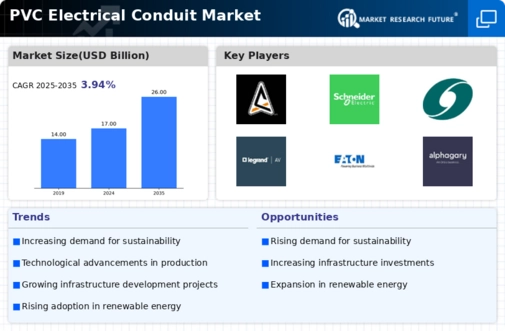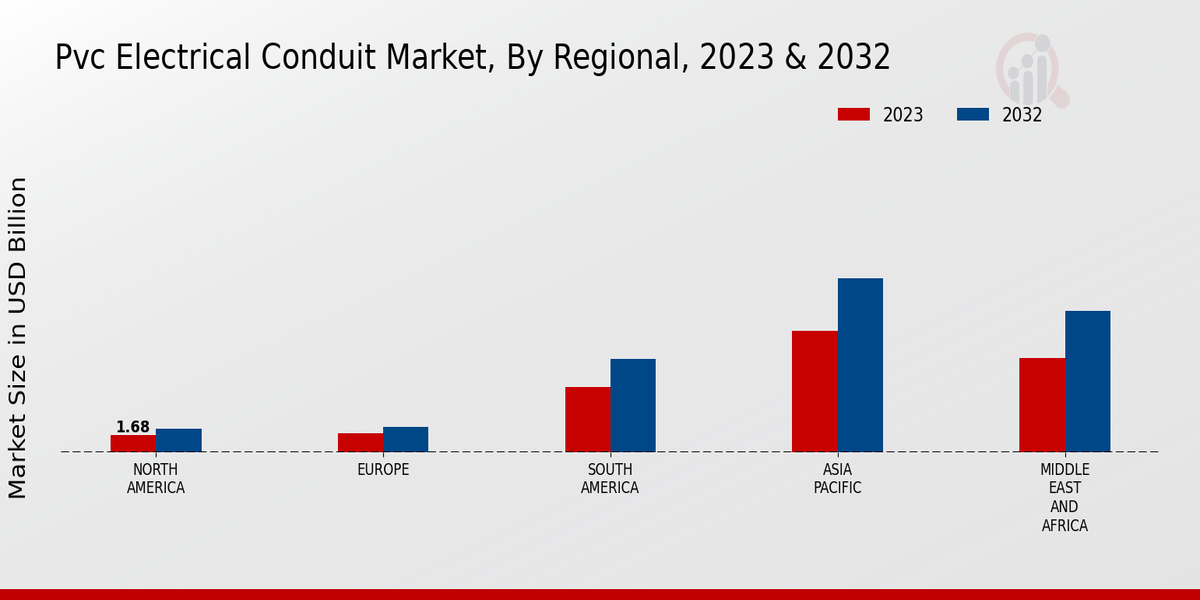Market Growth Projections
The Global PVC Electrical Conduit Market Industry is poised for substantial growth, with projections indicating a market size of 17.0 USD Billion in 2024 and an expected rise to 26.0 USD Billion by 2035. This growth trajectory suggests a compound annual growth rate of 3.94% from 2025 to 2035. Such figures reflect the increasing reliance on PVC conduits in various applications, driven by factors such as infrastructure development, safety regulations, and technological advancements. The market's expansion is indicative of the broader trends within the electrical and construction industries, highlighting the pivotal role of PVC conduits in modern electrical systems.
Increased Focus on Safety Standards
Safety regulations and standards are becoming increasingly stringent across various sectors, thereby impacting the Global PVC Electrical Conduit Market Industry. Compliance with these regulations necessitates the use of high-quality materials that can withstand environmental challenges. PVC conduits are recognized for their fire-resistant properties and ability to prevent electrical hazards, making them a suitable choice for compliance. As industries strive to meet these safety standards, the demand for PVC electrical conduits is likely to rise. This trend is indicative of a broader movement towards ensuring safety in electrical installations, which could further bolster market growth.
Expansion of the Construction Sector
The ongoing expansion of the construction sector is a pivotal driver for the Global PVC Electrical Conduit Market Industry. As new residential and commercial buildings are erected, the requirement for effective electrical systems becomes increasingly critical. PVC conduits are favored for their lightweight nature and ease of installation, making them ideal for modern construction practices. The construction industry's growth is projected to contribute significantly to the PVC conduit market, with a compound annual growth rate of 3.94% anticipated from 2025 to 2035. This expansion underscores the essential role of PVC conduits in supporting the electrical infrastructure of new developments.
Rising Adoption of Renewable Energy Sources
The transition towards renewable energy sources is influencing the Global PVC Electrical Conduit Market Industry significantly. As solar and wind energy installations proliferate, the need for effective electrical conduits to protect wiring systems becomes paramount. The adoption of these energy sources is expected to drive the market, as PVC conduits offer durability and resistance to environmental factors. This trend aligns with the projected growth of the market, which is anticipated to reach 26.0 USD Billion by 2035. The integration of PVC conduits in renewable energy projects enhances safety and efficiency, making them a preferred choice among developers.
Growing Demand for Infrastructure Development
The Global PVC Electrical Conduit Market Industry is experiencing a surge in demand driven by extensive infrastructure development initiatives worldwide. Governments are increasingly investing in urbanization and modernization projects, which necessitate robust electrical systems. For instance, the global market for PVC electrical conduits is projected to reach 17.0 USD Billion in 2024, reflecting the industry's response to these infrastructural needs. This growth is likely to be sustained as countries focus on enhancing their electrical grids and expanding urban areas, thereby creating a favorable environment for PVC conduit manufacturers.
Technological Advancements in Manufacturing Processes
Technological innovations in the manufacturing processes of PVC electrical conduits are enhancing product quality and reducing costs, thereby benefiting the Global PVC Electrical Conduit Market Industry. Advanced extrusion techniques and automated production lines are enabling manufacturers to produce conduits that meet diverse specifications while maintaining competitive pricing. These advancements not only improve the durability and performance of PVC conduits but also expand their applications across various sectors, including residential, commercial, and industrial. As a result, the market is likely to witness an uptick in demand, driven by the availability of superior products that cater to evolving consumer needs.










